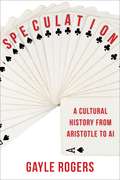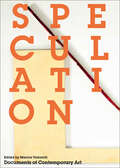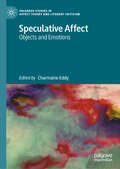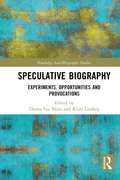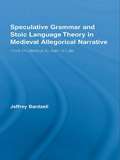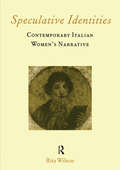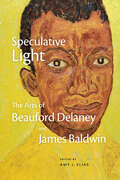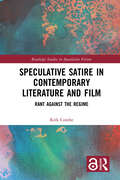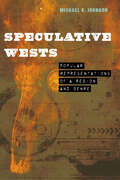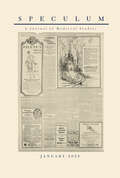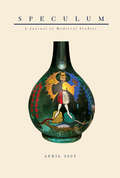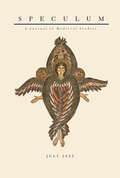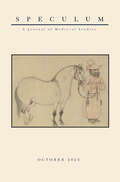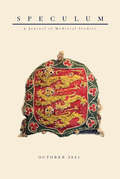- Table View
- List View
Speculation: A Cultural History from Aristotle to AI
by Gayle RogersIn the modern world, why do we still resort to speculation? Advances in scientific and statistical reasoning are supposed to have provided greater certainty in making claims about the future. Yet we constantly spin out scenarios about tomorrow, for ourselves or for entire societies, with flimsy or no evidence. Insubstantial speculations—from utopian thinking to high-risk stock gambles—often provoke fierce backlash, even when they prove prophetic for the world we come to inhabit. Why does this hypothetical way of thinking generate such controversy?In this cultural, literary, and intellectual history, Gayle Rogers traces debates over speculation from antiquity to the present. Celebrated by Boethius as the height of humanity’s mental powers but denigrated as sinful by John Calvin, speculation eventually became central to the scientific revolution’s new methods of seeing the natural world. In the nineteenth century, writers such as Jane Austen used the concept to diagnose the marriage market, redefining speculation for the purpose of social critique. Speculation fueled the development of modern capitalism, spurring booms, busts, and bubbles, and recently artificial intelligence has automated the speculation previously done by humans, with uncertain and troubling consequences. Unraveling these histories and many other disputes, Rogers argues that what has always been at stake in arguments over speculation, and why it so often appears so threatening, is the authority to produce and control knowledge about the future.Recasting centuries of contests over the power to anticipate tomorrow, this book reveals the crucial role speculation has played in how we create—and potentially destroy—the future.
Speculation: Forms Of Value Subjectivity In Art And Capital (Whitechapel: Documents of Contemporary Art #176)
by Marina VishmidtA wide-ranging investigation of what speculation is, and what is at stake for artistic, curatorial, critical, and institutional practices in relating to their own speculative character.Engaging with the question of speculation in ways that encompass the artistic, the economic, and the philosophical, with excursions into the literary and the scientific, this collection approaches the theme as a powerful logic of contemporary life whose key instantiations are art and finance. Both are premised on the power of contingency, temporality, and experimentation in the creation (and capitalization) of possible worlds. Artistic autonomy, and the self-legislation of the space of art, have often been seen as the freedom to speculate wildly on material and social possibilities. In this context, the artist is seen as a speculative subject and a paragon of creativity—the diametrical opposite of the bean-counter obsessed with balance sheets and value added. However, once social reality becomes speculative and opaque in its own right—risky, algorithmic, and overhauled by networked markets—what becomes of the distinction between not just art and finance but art and life?This anthology surveys material and social inventiveness from the ground up, speculating with technologies, gender, constructs of the family, and systems of logistics and coordination. An ecology of speculation is traced—one that is as broken, specific, and enthralling as the world.Artists Surveyed include Bertolt Brecht, Jerzy Ludwiński, Cameron Rowland, Salvage Art Institute, Andy Warhol, Mi You, PiraMMMida, Sam LewittWriters Include Lisa Adkins, Ramon Amaro, Brenna Bhandar, Octavia Butler, Cédric Durand, Georg Wilhelm Friedrich Hegel, Sophie Lewis, Dougal Dixon, Stanisław Lem, Isabelle Stengers and Phillip Pignarre, Steven Shaviro, Can Xue, Daniel Spaulding
Speculative Affect: Objects and Emotions (Palgrave Studies in Affect Theory and Literary Criticism)
by Charmaine EddySpeculative Affect: Objects and Emotions is an edited collection examining the intersection between affect and objects in the fields of literature, cultural theory, and cultural production. The word “speculative” in the title references recent philosophical and cultural work in the “speculative turn,” a philosophical field that includes speculative realism, new materialisms, “thing” theory, or object-oriented ontology, where the object is analyzed apart from human consciousness and human use-value. By linking this return to an ontological object realism beyond human consciousness with affect theory’s reimagining of corporeality by exploring attachments, bodily sensations, autonomic responses, and emotions as embodied forces beyond conscious knowing, this work addresses the last frontier in radically reconfiguring the status of human life – the division and hierarchy between so-called inert material and the apparent “superiority” of humanity.
Speculative Biography: Experiments, Opportunities and Provocations (Routledge Auto/Biography Studies)
by Donna Lee BrienWhile speculation has always been crucial to biography, it has often been neglected, denied or misunderstood. This edited collection brings together a group of international biographers to discuss how, and why, each uses speculation in their work; whether this is to conceptualise a project in its early stages, work with scanty or deliberately deceptive sources, or address issues associated with shy or stubborn subjects. After defining the role of speculation in biography, the volume offers a series of work-in-progress case studies that discuss the challenges biographers encounter and address in their work. In addition to defining the ‘speculative spectrum’ within the biographical endeavour, the collection offers a lexicon of new terms to describe different types of biographical speculation, and more deeply engage with the dynamic interplay between research, subjectivity and that which Natalie Zemon Davis dubbed ‘informed imagination’. By mapping the field of speculative biography, the collection demonstrates that speculation is not only innate to biographical practice but also key to rendering the complex mystery of biographical subjects, be they human, animal or even metaphysical.
Speculative Grammar and Stoic Language Theory in Medieval Allegorical Narrative: From Prudentius to Alan of Lille (Studies in Medieval History and Culture)
by Jeffrey BardzellIn his Plaint of Nature (De planctu Naturae), Alan of Lille bases much of his argument against sin in general and homosexuality in particular on the claim that both amount to bad grammar. The book explores the philosophical uses of grammar that were so formative of Alan’s thinking in major writers of the preceding generations, including Garland the Computist, St. Anselm, and Peter Abelard. Many of the linguistic theories on which these thinkers rely come from Priscian, an influential sixth-century grammarian, who relied more on the ancient tradition of Stoic linguistic theory than the Aristotelian one in elaborating his grammatical theory. Against this backdrop, the book provides a reading of Prudentius’ Psychomachia and presents an analysis of allegory in light of Stoic linguistic theory that contrasts other modern theories of allegorical signification and readings of Prudentius. The book establishes that Stoic linguistic theory is compatible with and likely partially formative of both the allegorical medium itself and the ideas expressed within it, in particular as they appeared in the allegories of Prudentius, Boethius, and Alan.
Speculative Identities: Contemporary Italian Women's Narrative
by Rita Wilson"Since the early 1980s, the novel has been deemed by many Italian women writers to be the most apt vehicle for creating positive images of the future of women. The novel becomes the space for confession, while at the same time allowing greater expressive freedom. There is no longer one voice for the ""feminine role"" and, by creating heroines who are also intellectuals, these authors offer their readers models of alternative versions of self. This study is a partial inventory of the new women's narrative and aims to provide a broad literary framework through which both the general reader and the student can appreciate the characteristics and innovations of contemporary Italian women's fiction. The writers chosen for this study (Ginerva Bompiani, Edith Bruck, Paola Capriolo, Francesca Duranti, Rosetta Loy, Giuliana Morandini, Marta Morazzoni, Anna Maria Ortese, Sandra Petrignanni, Fabrizia Ramondino, Elisabetta Rasy and Francesca Sanvitale) have achieved both critical acclaim and public recognition and their texts show the richness of voices, topics and structures in Italian women's writing today."
Speculative Light: The Arts of Beauford Delaney and James Baldwin
by Amy J EliasOver the course of a thirty-eight-year friendship, painter Beauford Delaney and writer James Baldwin shared their private lives and shaped one another’s artistic values. Speculative Light brings together scholars, critics, and artists who analyze the stylistic and historical import of Delaney's and Baldwin’s works and examine how this friendship fundamentally shaped the pair's ideas about art and life. The book’s contributors explore how the two men, sharing identities as queer Black American artists, first in New York and then as expatriates in France, created a speculative space in their work to think about more just and creative Black futures. Essay topics and issues range from masculinity, queerness, Blackness, and Americanness to the relationship between jazz, painting, and writing. Throughout, the contributors establish a positive history for Delaney's and Baldwin’s arts that refuses a subordinate role to white artists of the modernist avant-garde. Ultimately, Speculative Light demonstrates that Delaney and Baldwin's bond provides revolutionary grounds for theorizing contemporary Black art and life.Contributors. Hilton Als, Nicholas Boggs, Indie A. Choudhury, Shawn Anthony Christian, Rachel Cohen, Amy J. Elias, Monika Gehlawat, David Leeming, D. Quentin Miller, Fred Moten, Walton M. Muyumba, Robert O’Meally, Ed Pavlić, Levi Prombaum, Robert Reid-Pharr, Tyler T. Schmidt, Abbe Schriber, Jered Sprecher, Stephen C. Wicks, Magdalena Zaborowska
Speculative Satire in Contemporary Literature and Film: Rant Against the Regime (Routledge Studies in Speculative Fiction)
by Kirk CombeSince 1980, when neoliberal and neoconservative forces began their hostile takeover of western culture, a new type of political satire has emerged that works to unmask and deter those toxic doctrines. Literary and cultural critic Kirk Combe calls this new form of satire the Rant. The Rant is grim, highly imaginative, and complex in its blending of genres. It mixes facets of satire, science fiction, and monster tale to produce widely consumed spectacles—major studio movies, popular television/streaming series, bestselling novels—designed to disturb and to provoke. The Rant targets what Combe calls the Regime. Simply put, the Regime is the sum of the dangerous social, economic, and political orthodoxies spurred on by neoliberal and neoconservative polity. Such practices include free-market capitalism, corporatism, militarism, religiosity, imperialism, racism, patriarchy, and so on. In the Rant, then, we have a unique and wholly contemporary genre of political expression and protest: speculative satire.
Speculative Satire in Contemporary Literature and Film: Rant Against the Regime (Routledge Studies in Speculative Fiction)
by Kirk CombeSince 1980, when neoliberal and neoconservative forces began their hostile takeover of western culture, a new type of political satire has emerged that works to unmask and deter those toxic doctrines. Literary and cultural critic Kirk Combe calls this new form of satire the Rant. The Rant is grim, highly imaginative, and complex in its blending of genres. It mixes facets of satire, science fiction, and monster tale to produce widely consumed spectacles—major studio movies, popular television/streaming series, bestselling novels—designed to disturb and to provoke. The Rant targets what Combe calls the Regime. Simply put, the Regime is the sum of the dangerous social, economic, and political orthodoxies spurred on by neoliberal and neoconservative polity. Such practices include free-market capitalism, corporatism, militarism, religiosity, imperialism, racism, patriarchy, and so on. In the Rant, then, we have a unique and wholly contemporary genre of political expression and protest: speculative satire.
Speculative Wests: Popular Representations of a Region and Genre (Postwestern Horizons)
by Michael K. JohnsonLooking across the cultural landscape of the twenty-first century, its literature, film, television, comic books, and other media, we can see multiple examples of what Shelley S. Rees calls a &“changeling western,&” what others have called &“weird westerns,&” and what Michael K. Johnson refers to as &“speculative westerns&”—that is, hybrid western forms created by merging the western with one or more speculative genres or subgenres, including science fiction, fantasy, horror, and alternate history.Speculative Wests investigates both speculative westerns and other speculative texts that feature western settings. Just as &“western&” refers both to a genre and a region, Johnson&’s narrative involves a study of both genre and place, a study of the &“speculative Wests&” that have begun to emerge in contemporary texts such as the zombie-threatened California of Justina Ireland&’s Deathless Divide (2020), the reimagined future Navajo nation of Rebecca Roanhorse&’s Sixth World series (2018–19), and the complex temporal and geographic borderlands of Alfredo Véa&’s time travel novel The Mexican Flyboy (2016). Focusing on literature, film, and television from 2016 to 2020, Speculative Wests creates new visions of the American West.
Speculum, volume 100 number 1 (January 2025)
by SpeculumThis is volume 100 issue 1 of Speculum. Speculum, an English-language quarterly founded in 1926, was the first journal in North America devoted to the Middle Ages. It is open to contributions in all fields and methodologies studying the Middle Ages, a period that ranges from approximately 500 to 1500. The journal welcomes scholarship that takes a global approach as well as articles that bridge disciplines and appeal to a broad cross section of medievalists. European, Arabic, Byzantine, Hebrew, and Slavic studies are included.
Speculum, volume 100 number 2 (April 2025)
by SpeculumThis is volume 100 issue 2 of Speculum. Speculum, an English-language quarterly founded in 1926, was the first journal in North America devoted to the Middle Ages. It is open to contributions in all fields and methodologies studying the Middle Ages, a period that ranges from approximately 500 to 1500. The journal welcomes scholarship that takes a global approach as well as articles that bridge disciplines and appeal to a broad cross section of medievalists. European, Arabic, Byzantine, Hebrew, and Slavic studies are included.
Speculum, volume 100 number 3 (July 2025)
by SpeculumThis is volume 100 issue 3 of Speculum. Speculum, an English-language quarterly founded in 1926, was the first journal in North America devoted to the Middle Ages. It is open to contributions in all fields and methodologies studying the Middle Ages, a period that ranges from approximately 500 to 1500. The journal welcomes scholarship that takes a global approach as well as articles that bridge disciplines and appeal to a broad cross section of medievalists. European, Arabic, Byzantine, Hebrew, and Slavic studies are included.
Speculum, volume 100 number 4 (October 2025)
by SpeculumThis is volume 100 issue 4 of Speculum. Speculum, an English-language quarterly founded in 1926, was the first journal in North America devoted to the Middle Ages. It is open to contributions in all fields and methodologies studying the Middle Ages, a period that ranges from approximately 500 to 1500. The journal welcomes scholarship that takes a global approach as well as articles that bridge disciplines and appeal to a broad cross section of medievalists. European, Arabic, Byzantine, Hebrew, and Slavic studies are included.
Speculum, volume 96 number 4 (October 2021)
by SpeculumThis is volume 96 issue 4 of Speculum. Speculum, an English-language quarterly founded in 1926, was the first journal in North America devoted to the Middle Ages. It is open to contributions in all fields and methodologies studying the Middle Ages, a period that ranges from approximately 500 to 1500. The journal welcomes scholarship that takes a global approach as well as articles that bridge disciplines and appeal to a broad cross section of medievalists. European, Arabic, Byzantine, Hebrew, and Slavic studies are included.
Speculum, volume 97 number 1 (January 2022)
by SpeculumThis is volume 97 issue 1 of Speculum. Speculum, an English-language quarterly founded in 1926, was the first journal in North America devoted to the Middle Ages. It is open to contributions in all fields and methodologies studying the Middle Ages, a period that ranges from approximately 500 to 1500. The journal welcomes scholarship that takes a global approach as well as articles that bridge disciplines and appeal to a broad cross section of medievalists. European, Arabic, Byzantine, Hebrew, and Slavic studies are included.
Speculum, volume 97 number 2 (April 2022)
by SpeculumThis is volume 97 issue 2 of Speculum. Speculum, an English-language quarterly founded in 1926, was the first journal in North America devoted to the Middle Ages. It is open to contributions in all fields and methodologies studying the Middle Ages, a period that ranges from approximately 500 to 1500. The journal welcomes scholarship that takes a global approach as well as articles that bridge disciplines and appeal to a broad cross section of medievalists. European, Arabic, Byzantine, Hebrew, and Slavic studies are included.
Speculum, volume 97 number 3 (July 2022)
by SpeculumThis is volume 97 issue 3 of Speculum. Speculum, an English-language quarterly founded in 1926, was the first journal in North America devoted to the Middle Ages. It is open to contributions in all fields and methodologies studying the Middle Ages, a period that ranges from approximately 500 to 1500. The journal welcomes scholarship that takes a global approach as well as articles that bridge disciplines and appeal to a broad cross section of medievalists. European, Arabic, Byzantine, Hebrew, and Slavic studies are included.
Speculum, volume 97 number 4 (October 2022)
by SpeculumThis is volume 97 issue 4 of Speculum. Speculum, an English-language quarterly founded in 1926, was the first journal in North America devoted to the Middle Ages. It is open to contributions in all fields and methodologies studying the Middle Ages, a period that ranges from approximately 500 to 1500. The journal welcomes scholarship that takes a global approach as well as articles that bridge disciplines and appeal to a broad cross section of medievalists. European, Arabic, Byzantine, Hebrew, and Slavic studies are included.
Speculum, volume 98 number 1 (January 2023)
by SpeculumThis is volume 98 issue 1 of Speculum. Speculum, an English-language quarterly founded in 1926, was the first journal in North America devoted to the Middle Ages. It is open to contributions in all fields and methodologies studying the Middle Ages, a period that ranges from approximately 500 to 1500. The journal welcomes scholarship that takes a global approach as well as articles that bridge disciplines and appeal to a broad cross section of medievalists. European, Arabic, Byzantine, Hebrew, and Slavic studies are included.
Speculum, volume 98 number 2 (April 2023)
by SpeculumThis is volume 98 issue 2 of Speculum. Speculum, an English-language quarterly founded in 1926, was the first journal in North America devoted to the Middle Ages. It is open to contributions in all fields and methodologies studying the Middle Ages, a period that ranges from approximately 500 to 1500. The journal welcomes scholarship that takes a global approach as well as articles that bridge disciplines and appeal to a broad cross section of medievalists. European, Arabic, Byzantine, Hebrew, and Slavic studies are included.
Speculum, volume 98 number 4 (October 2023)
by SpeculumThis is volume 98 issue 4 of Speculum. Speculum, an English-language quarterly founded in 1926, was the first journal in North America devoted to the Middle Ages. It is open to contributions in all fields and methodologies studying the Middle Ages, a period that ranges from approximately 500 to 1500. The journal welcomes scholarship that takes a global approach as well as articles that bridge disciplines and appeal to a broad cross section of medievalists. European, Arabic, Byzantine, Hebrew, and Slavic studies are included.
Speculum, volume 99 number 1 (January 2024)
by SpeculumThis is volume 99 issue 1 of Speculum. Speculum, an English-language quarterly founded in 1926, was the first journal in North America devoted to the Middle Ages. It is open to contributions in all fields and methodologies studying the Middle Ages, a period that ranges from approximately 500 to 1500. The journal welcomes scholarship that takes a global approach as well as articles that bridge disciplines and appeal to a broad cross section of medievalists. European, Arabic, Byzantine, Hebrew, and Slavic studies are included.
Speculum, volume 99 number 2 (April 2024)
by SpeculumThis is volume 99 issue 2 of Speculum. Speculum, an English-language quarterly founded in 1926, was the first journal in North America devoted to the Middle Ages. It is open to contributions in all fields and methodologies studying the Middle Ages, a period that ranges from approximately 500 to 1500. The journal welcomes scholarship that takes a global approach as well as articles that bridge disciplines and appeal to a broad cross section of medievalists. European, Arabic, Byzantine, Hebrew, and Slavic studies are included.
Speculum, volume 99 number 3 (July 2024)
by SpeculumThis is volume 99 issue 3 of Speculum. Speculum, an English-language quarterly founded in 1926, was the first journal in North America devoted to the Middle Ages. It is open to contributions in all fields and methodologies studying the Middle Ages, a period that ranges from approximately 500 to 1500. The journal welcomes scholarship that takes a global approach as well as articles that bridge disciplines and appeal to a broad cross section of medievalists. European, Arabic, Byzantine, Hebrew, and Slavic studies are included.
